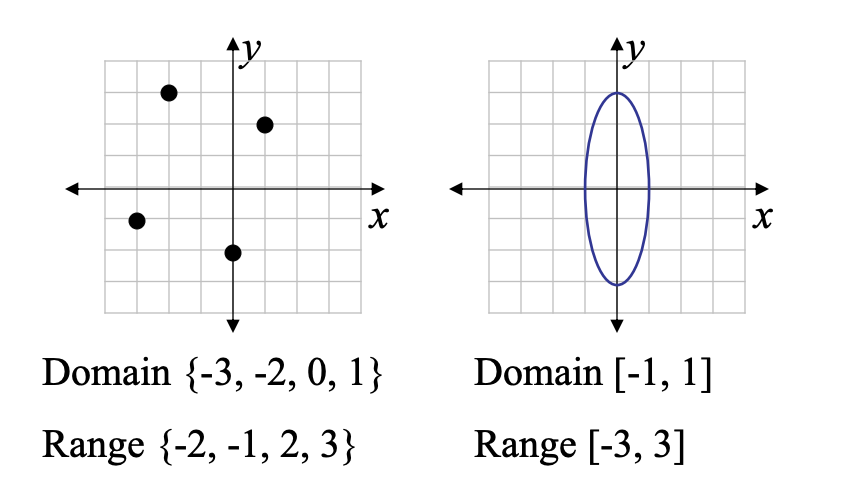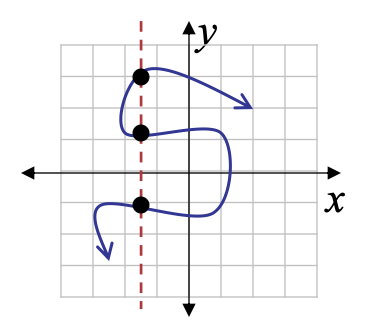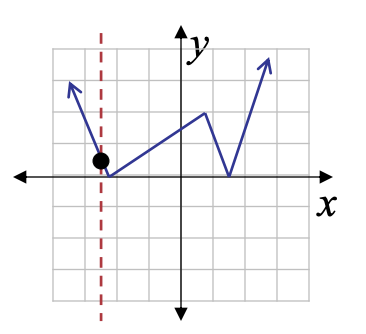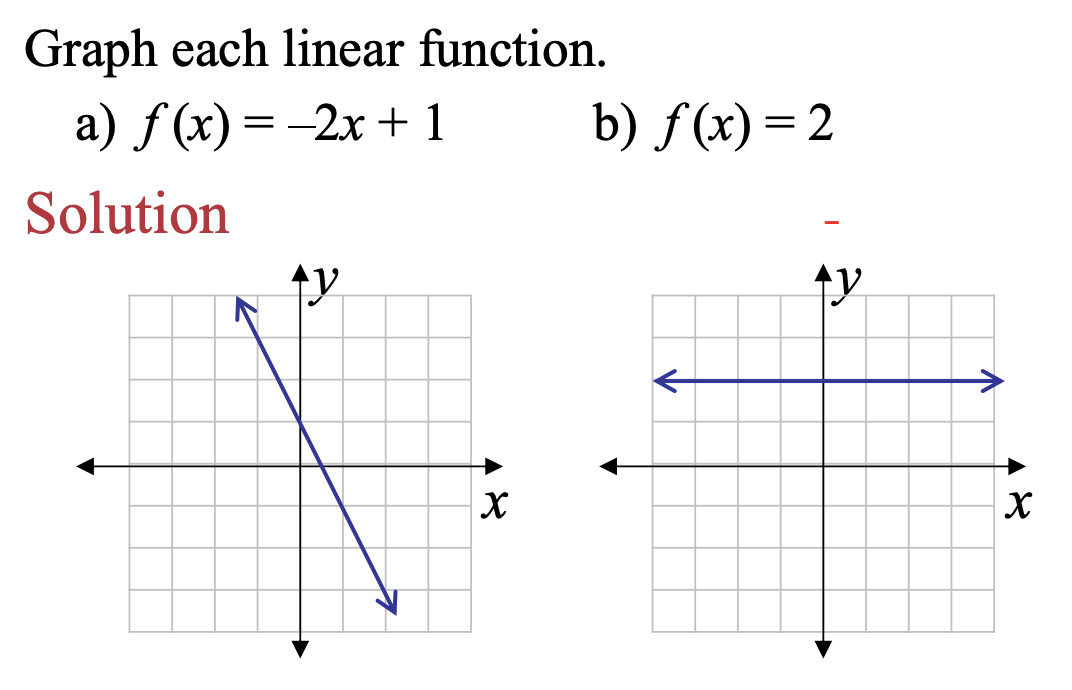[Func-Num] 8.4 An Introduction to Functions: Linear Functions, Applications, and Models
Categories: Func-Num
Tags: Functions
📋 This is my note-taking from what I learned in the class “Math175-002 Functions & Number Systems”
OBJECTIVES
- Interpret the terms relation, function, domain, range, independent variable, and dependent variable in mathematical exposition.
- Use function notation.
- Identify a linear function and graph it.
- Perform cost analysis using linear functions.
- Construct a linear model from a set of data points
Linear Functions, Applications, and Models
- Relations and Functions
- Domain and Range
- Graphs of Relations
- Graphs of Functions
- Function Notation
- Linear Functions
- Modeling with Linear Functions
Terminology
If the value of the variable y depends on the value of the variable x, the y is the dependent variable and x the independent variable.

1-1. Relations
A relation is a set of ordered pairs.
For example, the sets
- F = {(1, 2), (–1, 5), (4, 3)}
- G = {(1, 5), (9, 0), (9, 8)}
→ Both F and G are relations!
1-2. Functions
A function is a relation in which for each value of the first component of the ordered pairs there is exactly one value of the second component.
Of the two sets,
- F = {(1, 2), (–1, 5), (4, 3), (2, 5)}
- G = {(1, 5), (9, 0), (9, 8)}
→ Only F is a function and G is a just relation!
- Because only F is a function because each x value has only one y value. G is a relation since x = 9 is having more than one y value; y = 0 and 8.
- Note for function F, two x = -1 and 2 have y = 5. So, in a Function multiple x can have same y, but a single x can’t have multiple y.
Example: Determining Independent and Dependent Variables
Determine the independent and dependent variables for the following. The procedure by which someone uses a calculator that finds square roots; y = \(\sqrt {x}\)
Solution
- The independent variable (input) is a nonnegative real number; x.
- The dependent variable (output) is the positive principal square root; y.
- y value DEPENDS on our selected value for x.
- For example (81, 9) belongs to this function.
2. Domain and Range
In a relation, the set of all values of the independent variable (x) is the domain.
The set of all values of the dependent variable (y) is the range.
Example: Determining Domain and Range
Give the domain and range of y = \(\sqrt {x}\)
Solution
- The domain (x) is restricted to the nonnegative numbers: [0, ∞)
- The range (y) also is only the principal positive root: [0, ∞)
3. Graphs of Relations
- The graph of a relation is the graph of its ordered pairs.
- The graph gives a picture of the relation, which can be used to determine its domain and range.
Example: Determining Domain and Range 1

Example: Determining Domain and Range 2

Agreement on Domain
The domain of a relation is assumed to be all real numbers that produce real numbers when substituted for the independent variable.
4. Graphs of Functions
- In a function, each value of x leads to only one value of y, so any vertical line drawn through the graph of a function must intersect the graph in at most one point.
- This is called the vertical line test for a function.
- If a vertical line intersects the graph of at more than one point, then it is for a relation not for a function.
Example: Vertical Line Test
| Vertical Line Test | |
|---|---|
 |
Not a function → The same x-value corresponds to multiple y-values |
 |
Function → each x-value corresponds to only one y-value |
Example: Determining Whether a Relation is a Function 1
Determine whether each equation defines a function and give the domain and range. → y = \(\sqrt {x + 1}\)
Note that for square root function, Domain of x values must have what is under the root ≥ 0
Solution
- Yes, it is a function
- To find the domain note that x + 1 >= 0.
- The domain is [-1, ∞) and The range is [0, ∞)
Example: Determining Whether a Relation is a Function 2
Determine whether each equation defines a function and give the domain and range. → y2 = x
Solution
- No, it is not a function
- (16, 4) and (16, -4) both work. (In a Function, multiple x can have same y, but a single x can’t have multiple y.)
- The domain is [0, ∞) and The range is (-∞, ∞)
Example: Determining Whether a Relation is a Function 3
Determine whether each equation defines a function and give the domain and range. → y <= 2x
Solution
- No, it is not a function
- For example, if x = 1, then any y value less than or equal to 2 would satisfy the inequality, so there are infinitely many possible y values for x = 1.
- The domain and range are (-∞, ∞)
Example: Determining Whether a Relation is a Function 4
Determine whether each equation defines a function and give the domain and range. → y = \({3} \over {x - 2}\)
Note that for fractional function, Domain of x values must have “denominator ≠ 0”
Solution
- Yes, it is a function
- The domain is (-∞, 2] U [2, ∞), since we avoid 0 in the denominator.
- The range is (-∞, 0] U [0, ∞)
Variations of the Definition of Function
- A function is a relation in which for each value of the first component of the ordered pairs there is exactly one value of the second component.
- A function is a set of distinct ordered pairs in which no first component is repeated.
- A function is a rule or correspondence that assigns exactly one range value to each domain value.
5. Function Notation
When a function f is defined with a rule or an equation using x and y for the independent and dependent variables, we say “y is a function of x” to emphasize that y depends on x. We use the notation y = f (x), called function notation, to express this and read f (x) as “f of x.” For example if y = 3x + 1, we write f(x) = 3x + 1.
- Note that f (x) is just another name for the dependent variable y.
-
- If f (x) = 3x + 1, we find f(2) by replacing x with 2, f(2) = 3(2) + 1 = 7
-
- Read f(2) as “f of 2” or “f at 2.”
Example: Using Function Notation
Let f(x) = x2 + 3x – 1. Find the following.
- a) f(2) = 22 + 3(2) -1 = 9
- b) f(0) = 0 + 0 - 1 = -1
- c) f(2x) = (2x)2 + 3(2x) - 1 = 4x2 + 6x - 1
6. Linear Functions
A function that can be written in the form f(x) = mx + b for real numbers m and b is a linear function.
Example: Graphing Linear Functions
Graph each linear function.

7. Modeling with Linear Functions
Example: Modeling with Linear Functions 1
A company produces DVDs of live concerts. The company pays $200 for advertising the DVDs. Each DVD costs $12 to produce and the company charges $20 per disk.
- a) Express the cost C as a function of x, the number of DVDs produced.
The fixed cost is $200 and for each DVD produced, the variable cost is $12. The cost C can be expressed as a function of x, the number of DVDs produced: C(x) = 12x + 200.
Example: Modeling with Linear Functions 2
A company produces DVDs of live concerts. The company pays $200 for advertising the DVDs. Each DVD costs $12 to produce and the company charges $20 per disk.
- b) Express the revenue R as a function of x, the number of DVDs sold.
Each DVD sells for $20, so revenue R is given by: R(x) = 20x.
Example: Modeling with Linear Functions 3
A company produces DVDs of live concerts. The company pays $200 for advertising the DVDs. Each DVD costs $12 to produce and the company charges $20 per disk.
- c) When will the company break-even? That is, for what value of x does revenue equal cost?
The company will just break even (no profit and no loss) as long as revenue just equals cost, or C(x) = R(x).
This is true whenever
- 12x + 200 = 20x
- 200 = 8x
- 25 = x.
If 25 DVDs are produced and sold, the company will break even.

Leave a comment